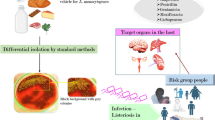Abstract
K99 Fimbriae from enterotoxigenicEscherichia coli (ETEC) were found to bind specifically to sialic acid, as measured in a haemagglutination inhibition assay using the intact bacteria and human erythrocytes. The affinity forN-glycolylneuraminic acid was about twice that ofN-acetylneuraminic acid (NeuAc), and other monosaccharides were found to be at least ten-fold less effective as inhibitors. The specificity was found to depend on electrostatic interaction where the carboxyl group and its orientation plays an important role. 2-α-Benzyl-NeuAc was a better inhibitor than 2-α-methyl-NeuAc suggesting a hydrophobic patch near the binding site on the protein. Axially oriented hydroxyl groups as in 4-epi-NeuAc and 3-hydroxy-NeuAc seemed to participate in binding since these derivatives were better inhibitors thanN-acetylneuraminic acid. K99 was found to have a higher affinity for 4-O-acetyl-NeuAc and lower affinity forN-acetylneuraminic acid withO-substituents at C7-C9 as compared toN-acetylneuraminic acid. Hence, the degree ofO-acetylation of sialic acid in the mucosa of the small intestine may influence colonization and determine susceptibility to infection.
Similar content being viewed by others
References
Moon HW, Nagy B, Isaacson RE, Ørskov I (1977) Infect Immun 15:614–25.
Smith HW, Linggood MA (1972) J Med Microbiol 5:243–50.
de Graaf FK, Klemm P, Gaastra W (1981) Infect Immun 33:877–83.
Lindahl M, Wadström T (1984) Vet Microbiol 9:249–57.
Faris A, Lindahl M, Wadström T (1980) FEMS Microbiol Lett 7:265–69.
Moon HW, Kohler EM, Schneider RA, Whipp SC (1980) Infect Immun 27:222–30.
Runnels PL, Moon HW, Schneider RA (1980) Infect Immun 28:298–300.
Guinée PAM, Jansen WH, Agterberg CM (1976) Infect Immun 13:1369–77.
Lindahl M, Faris A, Wadström T, Hjertén S (1981) Biochim Biophys Acta 677:471–76
Firon N, Ofek I, Sharon N (1983) Carbohydr Res 120:235–49.
Smit H, Gaastra W, Kamerling JP, Vliegenthart JFG, de Graaf FK (1984) Infect Immun 46:578–84.
Svenson SB, Källenius G, Möllby R, Hultberg M, Winberg J (1982) Infection 10:209–14.
Wu AM, Kabat EA, Gruezo FG, Poretz RD (1981) Arch Biochem Biophys 209:191–203.
Lindahl M, Wadström T (1986) FEMS Microbiol Lett 34:297–300.
Cohen E, Ilodi GHU, Korytnyk W, Sharma M (1983) Dev Comp Immunol 7:189–92.
Roche A-C, Monsigny M (1979) in Progress in Clinical and Biological Research, Vol 29, ed. Cohen E, Alan R Liss, New York, p 603.
Maget-Dana R, Roche A-C, Monsigny M (1979) in Progress in Clinical and Biological Research, Vol 29, ed. Cohen E, Alan R Liss, New York, p 567.
Ravindranath MH, Higa HH, Cooper EL, Paulson JC (1985) J Biol Chem 260:8850–56.
Miller RL (1982) J Invertebr Pathol 39:210–14.
Brossmer R, Holmquist L (1971) Hoppe Seylers Z Physiol Chem 352:1715.
Shaver R, Faillard H (1968) Hoppe Seylers Z Physiol Chem 349:961–68.
Ghidoni R, Sonnino S, Tettamanti G, Baumann N, Reuter B, Shaver R (1980) J Biol Chem 255:6990–95.
Kuhn R, Lutz P, MacDonald DL (1966) Chem Ber 99:611–17.
Brossmer R, Nebelin E (1969) FEBS Lett 4:335–36.
Culling CFA, Reid PE, Dunn WL, Clay MG (1977) J Clin Path 30:1063–67.
Author information
Authors and Affiliations
Rights and permissions
About this article
Cite this article
Lindahl, M., Brossmer, R. & Wadström, T. Carbohydrate receptor specificity of K99 fimbriae of enterotoxigenicEscherichia coli . Glycoconjugate J 4, 51–58 (1987). https://doi.org/10.1007/BF01048444
Received:
Issue Date:
DOI: https://doi.org/10.1007/BF01048444




